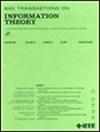基于Petz恢复态连续性的量子马尔可夫链最优层析
IF 2.9
3区 计算机科学
Q3 COMPUTER SCIENCE, INFORMATION SYSTEMS
引用次数: 0
摘要
在这项工作中,我们证明了Petz恢复状态$\rho _{BC}^{1/2}(\rho _{B}^{-1/2}\rho _{AB}\rho _{B}^{-1/2}\otimes I_{C})\rho _{BC}^{1/2}$对于其边缘$\rho _{AB}$和$\rho _{BC}$是连续的。对于不忠$1-F(\rho,\sigma)=1-\mathop {\mathrm {tr}}\nolimits |\sqrt {\rho }\sqrt {\sigma }|$和跟踪范数$\parallel \! \rho -\sigma \! \parallel _{1}=\mathop {\mathrm {tr}}\nolimits (|\rho -\sigma |)$,我们得到了以下与维度无关的估计:$1-F(\rho _{AB},\sigma _{AB}) \le \delta \hspace {.1cm}, 1-F(\rho _{BC},\sigma _{BC}) \le \delta \hspace {.1cm}\Longrightarrow 1-F(\rho _{ABC},\sigma _{ABC})\le 18\delta, \parallel \! \rho _{AB}-\sigma _{AB} \! \parallel _{1} \le \varepsilon \hspace {.1cm}, \parallel \! \rho _{BC}-\sigma _{BC} \! \parallel _{1} \le \varepsilon \hspace {.1cm}\Longrightarrow \parallel \! \rho _{ABC}-\sigma _{ABC} \! \parallel _{}\le \varepsilon +4\varepsilon ^{\frac {1}{2}}$。作为应用,我们得到了量子马尔可夫链断层扫描的以下应用:1)量子马尔可夫链断层扫描的样本复杂度,即未知量子马尔可夫链需要多少个副本才能确定状态,为$\tilde {\Theta }\left ({{\frac {(d_{A}^{2}+d_{C}^{2})d_{B}^{2}}{\delta }}}\right)$, $\tilde {\Theta }\left ({{\frac {(d_{A}^{2}+d_{C}^{2})d_{B}^{2}}{\epsilon ^{2}}}}\right)$,其中$\delta $表示不忠误差,$\epsilon $表示跟踪距离。2)量子马尔可夫链认证的样本复杂度,即证明一个三方状态是否等于给定的量子马尔可夫链$\sigma _{ABC}$或至少$\delta $ -远离$\sigma _{ABC}$,分别为${\Theta }\left ({{\frac {(d_{A}+d_{C})d_{B}}{\delta }}}\right)$和${\Theta }\left ({{\frac {(d_{A}+d_{C})d_{B}}{\epsilon ^{2}}}}\right)$。3) $\tilde {O}\left ({{\frac {\min \{d_{A}d_{B}^{3}d_{C}^{3},d_{A}^{3}d_{B}^{3}d_{C}\}}{\epsilon ^{2}}}}\right)$样本副本足以证明$\rho _{ABC}$是量子马尔可夫链还是$\epsilon $ -在痕量距离上远离其Petz恢复状态。这意味着,对于测试$\rho _{ABC}$是否为量子马尔可夫链(等于其Petz恢复状态),并不总是需要全态断层扫描。本文章由计算机程序翻译,如有差异,请以英文原文为准。
Optimal Tomography of Quantum Markov Chains via Continuity of Petz Recovery States
In this work, we show that the Petz recovered state $\rho _{BC}^{1/2}(\rho _{B}^{-1/2}\rho _{AB}\rho _{B}^{-1/2}\otimes I_{C})\rho _{BC}^{1/2}$ is continuous regarding its marginals $\rho _{AB}$ and $\rho _{BC}$ . In terms of infidelity $1-F(\rho,\sigma)=1-\mathop {\mathrm {tr}}\nolimits |\sqrt {\rho }\sqrt {\sigma }|$ and trace norm $\parallel \! \rho -\sigma \! \parallel _{1}=\mathop {\mathrm {tr}}\nolimits (|\rho -\sigma |)$ , we obtain the following dimension-independent estimate: $1-F(\rho _{AB},\sigma _{AB}) \le \delta \hspace {.1cm}, 1-F(\rho _{BC},\sigma _{BC}) \le \delta \hspace {.1cm}\Longrightarrow 1-F(\rho _{ABC},\sigma _{ABC})\le 18\delta, \parallel \! \rho _{AB}-\sigma _{AB} \! \parallel _{1} \le \varepsilon \hspace {.1cm}, \parallel \! \rho _{BC}-\sigma _{BC} \! \parallel _{1} \le \varepsilon \hspace {.1cm}\Longrightarrow \parallel \! \rho _{ABC}-\sigma _{ABC} \! \parallel _{}\le \varepsilon +4\varepsilon ^{\frac {1}{2}}$ . As applications, we obtain the following applications in tomography of quantum Markov chains: 1) The sample complexity of quantum Markov chain tomography, i.e., how many copies of an unknown quantum Markov chain are necessary and sufficient to determine the state, is $\tilde {\Theta }\left ({{\frac {(d_{A}^{2}+d_{C}^{2})d_{B}^{2}}{\delta }}}\right)$ , and $\tilde {\Theta }\left ({{\frac {(d_{A}^{2}+d_{C}^{2})d_{B}^{2}}{\epsilon ^{2}}}}\right)$ , where $\delta $ denotes infidelity error and $\epsilon $ denotes trace distance. 2) The sample complexity of quantum Markov chain certification, i.e., to certify whether a tripartite state equals a given quantum Markov chain $\sigma _{ABC}$ or at least $\delta $ -far from $\sigma _{ABC}$ , is ${\Theta }\left ({{\frac {(d_{A}+d_{C})d_{B}}{\delta }}}\right)$ , and ${\Theta }\left ({{\frac {(d_{A}+d_{C})d_{B}}{\epsilon ^{2}}}}\right)$ . 3) $\tilde {O}\left ({{\frac {\min \{d_{A}d_{B}^{3}d_{C}^{3},d_{A}^{3}d_{B}^{3}d_{C}\}}{\epsilon ^{2}}}}\right)$ copies of sample are sufficient to certify whether $\rho _{ABC}$ is a quantum Markov chain or $\epsilon $ -far from its Petz recovered state in trace distance. This implies that full state tomography is not always necessary for testing whether $\rho _{ABC}$ is a quantum Markov chain (equals to its Petz recovered state) or not.
求助全文
通过发布文献求助,成功后即可免费获取论文全文。
去求助
来源期刊

IEEE Transactions on Information Theory
工程技术-工程:电子与电气
CiteScore
5.70
自引率
20.00%
发文量
514
审稿时长
12 months
期刊介绍:
The IEEE Transactions on Information Theory is a journal that publishes theoretical and experimental papers concerned with the transmission, processing, and utilization of information. The boundaries of acceptable subject matter are intentionally not sharply delimited. Rather, it is hoped that as the focus of research activity changes, a flexible policy will permit this Transactions to follow suit. Current appropriate topics are best reflected by recent Tables of Contents; they are summarized in the titles of editorial areas that appear on the inside front cover.
 求助内容:
求助内容: 应助结果提醒方式:
应助结果提醒方式:


